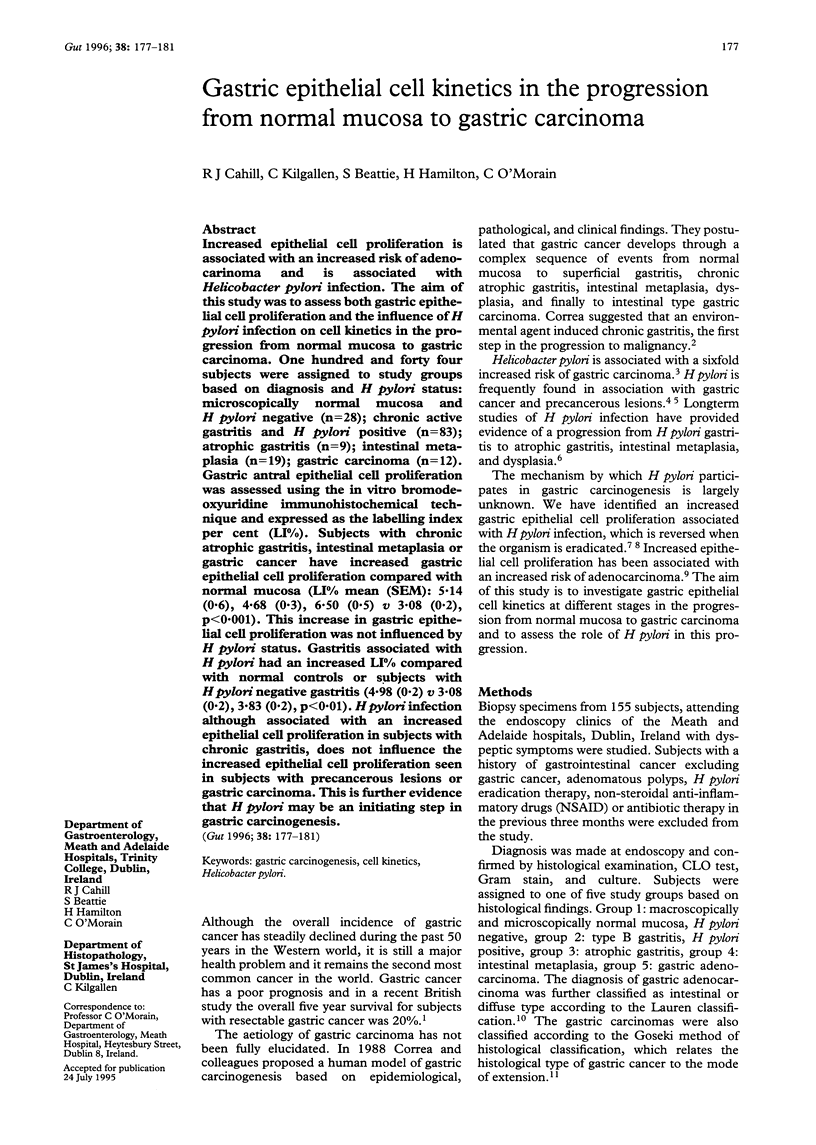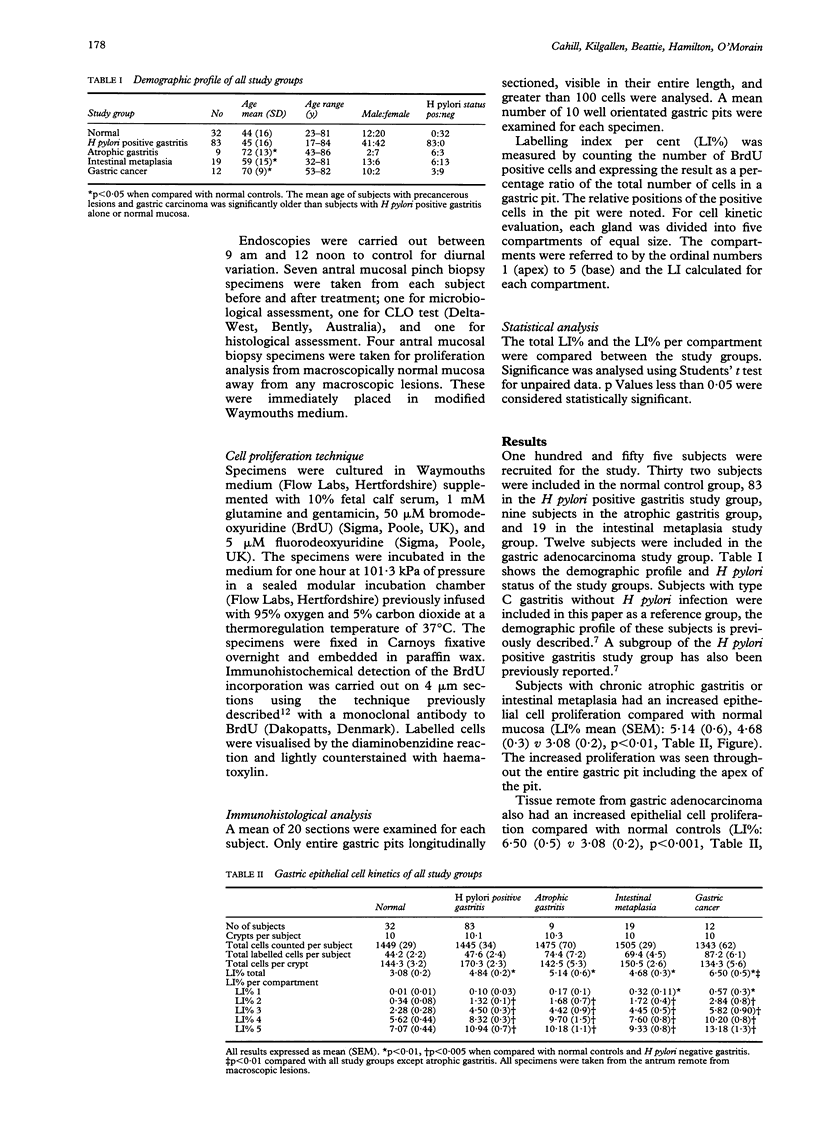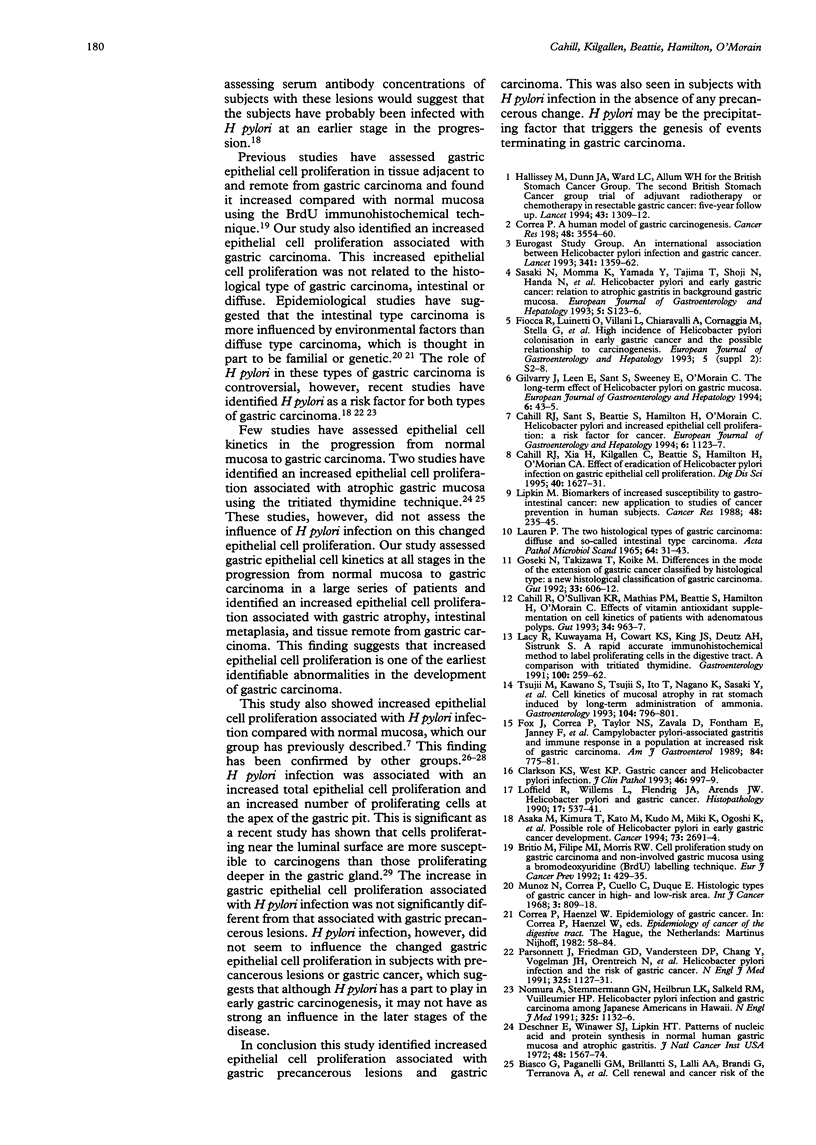Abstract
Increased epithelial cell proliferation is associated with an increased risk of adenocarcinoma and is associated with Helicobacter pylori infection. The aim of this study was to assess both gastric epithelial cell proliferation and the influence of H pylori infection on cell kinetics in the progression from normal mucosa to gastric carcinoma. One hundred and forty four subjects were assigned to study groups based on diagnosis and H pylori status: microscopically normal mucosa and H pylori negative (n = 28); chronic active gastritis and H pylori positive (n = 83); atrophic gastritis (n = 9); intestinal metaplasia (n = 19); gastric carcinoma (n = 12). Gastric antral epithelial cell proliferation was assessed using the in vitro bromodeoxyuridine immunohistochemical technique and expressed as the labelling index per cent (LI%). Subjects with chronic atrophic gastritis, intestinal metaplasia or gastric cancer have increased gastric epithelial cell proliferation compared with normal mucosa (LI% mean (SEM): 5.14 (0.6), 4.68 (0.3), 6.50 (0.5) v 3.08 (0.2), p < 0.001). This increase in gastric epithelial cell proliferation was not influenced by H pylori status. Gastritis associated with H pylori had an increased LI% compared with normal controls or subjects with H pylori negative gastritis (4.98 (0.2) v 3.08 (0.2), 3.83 (0.2), p < 0.01). H pylori infection although associated with an increased epithelial cell proliferation in subjects with chronic gastritis, does not influence the increased epithelial cell proliferation seen in subjects with precancerous lesions or gastric carcinoma. This is further evidence that H pylori may be an initiating step in gastric carcinogenesis.
Full text
PDF




Selected References
These references are in PubMed. This may not be the complete list of references from this article.
- An international association between Helicobacter pylori infection and gastric cancer. The EUROGAST Study Group. Lancet. 1993 May 29;341(8857):1359–1362. [PubMed] [Google Scholar]
- Asaka M., Kimura T., Kato M., Kudo M., Miki K., Ogoshi K., Kato T., Tatsuta M., Graham D. Y. Possible role of Helicobacter pylori infection in early gastric cancer development. Cancer. 1994 Jun 1;73(11):2691–2694. doi: 10.1002/1097-0142(19940601)73:11<2691::aid-cncr2820731107>3.0.co;2-2. [DOI] [PubMed] [Google Scholar]
- Biasco G., Paganelli G. M., Brillanti S., Lalli A. A., Brandi G., Terranova A., Miglioli M., Barbara L. Cell renewal and cancer risk of the stomach: analysis of cell proliferation kinetics in atrophic gastritis. Acta Gastroenterol Belg. 1989 May-Aug;52(3-4):361–366. [PubMed] [Google Scholar]
- Brenes F., Ruiz B., Correa P., Hunter F., Rhamakrishnan T., Fontham E., Shi T. Y. Helicobacter pylori causes hyperproliferation of the gastric epithelium: pre- and post-eradication indices of proliferating cell nuclear antigen. Am J Gastroenterol. 1993 Nov;88(11):1870–1875. [PubMed] [Google Scholar]
- Brito M. J., Filipe M. I., Morris R. W. Cell proliferation study on gastric carcinoma and non-involved gastric mucosa using a bromodeoxyuridine (BrdU) labelling technique. Eur J Cancer Prev. 1992 Oct;1(6):429–435. doi: 10.1097/00008469-199210000-00006. [DOI] [PubMed] [Google Scholar]
- Cahill R. J., O'Sullivan K. R., Mathias P. M., Beattie S., Hamilton H., O'Morain C. Effects of vitamin antioxidant supplementation on cell kinetics of patients with adenomatous polyps. Gut. 1993 Jul;34(7):963–967. doi: 10.1136/gut.34.7.963. [DOI] [PMC free article] [PubMed] [Google Scholar]
- Cahill R. J., Xia H., Kilgallen C., Beattie S., Hamilton H., O'Morain C. Effect of eradication of Helicobacter pylori infection on gastric epithelial cell proliferation. Dig Dis Sci. 1995 Aug;40(8):1627–1631. doi: 10.1007/BF02212681. [DOI] [PubMed] [Google Scholar]
- Clarkson K. S., West K. P. Gastric cancer and Helicobacter pylori infection. J Clin Pathol. 1993 Nov;46(11):997–999. doi: 10.1136/jcp.46.11.997. [DOI] [PMC free article] [PubMed] [Google Scholar]
- Deschner E. E., Winawer S. J., Lipkin M. Patterns of nucleic acid and protein synthesis in normal human gastric mucosa and atrophic gastritis. J Natl Cancer Inst. 1972 Jun;48(6):1567–1574. [PubMed] [Google Scholar]
- Fox J. G., Correa P., Taylor N. S., Zavala D., Fontham E., Janney F., Rodriguez E., Hunter F., Diavolitsis S. Campylobacter pylori-associated gastritis and immune response in a population at increased risk of gastric carcinoma. Am J Gastroenterol. 1989 Jul;84(7):775–781. [PubMed] [Google Scholar]
- Goseki N., Takizawa T., Koike M. Differences in the mode of the extension of gastric cancer classified by histological type: new histological classification of gastric carcinoma. Gut. 1992 May;33(5):606–612. doi: 10.1136/gut.33.5.606. [DOI] [PMC free article] [PubMed] [Google Scholar]
- Hallissey M. T., Dunn J. A., Ward L. C., Allum W. H. The second British Stomach Cancer Group trial of adjuvant radiotherapy or chemotherapy in resectable gastric cancer: five-year follow-up. Lancet. 1994 May 28;343(8909):1309–1312. doi: 10.1016/s0140-6736(94)92464-3. [DOI] [PubMed] [Google Scholar]
- LAUREN P. THE TWO HISTOLOGICAL MAIN TYPES OF GASTRIC CARCINOMA: DIFFUSE AND SO-CALLED INTESTINAL-TYPE CARCINOMA. AN ATTEMPT AT A HISTO-CLINICAL CLASSIFICATION. Acta Pathol Microbiol Scand. 1965;64:31–49. doi: 10.1111/apm.1965.64.1.31. [DOI] [PubMed] [Google Scholar]
- Lacy E. R., Kuwayama H., Cowart K. S., King J. S., Deutz A. H., Sistrunk S. A rapid, accurate, immunohistochemical method to label proliferating cells in the digestive tract. A comparison with tritiated thymidine. Gastroenterology. 1991 Jan;100(1):259–262. doi: 10.1016/0016-5085(91)90610-w. [DOI] [PubMed] [Google Scholar]
- Lipkin M. Biomarkers of increased susceptibility to gastrointestinal cancer: new application to studies of cancer prevention in human subjects. Cancer Res. 1988 Jan 15;48(2):235–245. [PubMed] [Google Scholar]
- Loffeld R. J., Willems I., Flendrig J. A., Arends J. W. Helicobacter pylori and gastric carcinoma. Histopathology. 1990 Dec;17(6):537–541. doi: 10.1111/j.1365-2559.1990.tb00793.x. [DOI] [PubMed] [Google Scholar]
- Muñoz N., Correa P., Cuello C., Duque E. Histologic types of gastric carcinoma in high- and low-risk areas. Int J Cancer. 1968 Nov 15;3(6):809–818. doi: 10.1002/ijc.2910030614. [DOI] [PubMed] [Google Scholar]
- Parsonnet J., Friedman G. D., Vandersteen D. P., Chang Y., Vogelman J. H., Orentreich N., Sibley R. K. Helicobacter pylori infection and the risk of gastric carcinoma. N Engl J Med. 1991 Oct 17;325(16):1127–1131. doi: 10.1056/NEJM199110173251603. [DOI] [PubMed] [Google Scholar]
- Sørbye H., Kvinnsland S., Svanes K. Effect of salt-induced mucosal damage and healing on penetration of N-methyl-N'-nitro-N-nitrosoguanidine to proliferative cells in the gastric mucosa of rats. Carcinogenesis. 1994 Apr;15(4):673–679. doi: 10.1093/carcin/15.4.673. [DOI] [PubMed] [Google Scholar]
- Tsujii M., Kawano S., Tsuji S., Ito T., Nagano K., Sasaki Y., Hayashi N., Fusamoto H., Kamada T. Cell kinetics of mucosal atrophy in rat stomach induced by long-term administration of ammonia. Gastroenterology. 1993 Mar;104(3):796–801. doi: 10.1016/0016-5085(93)91015-a. [DOI] [PubMed] [Google Scholar]


